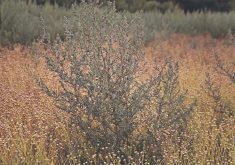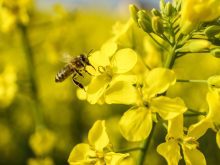Within the next few days, plain brown envelopes will be arriving in farm homes across Saskatchewan.
The envelopes are being mailed from Saskatoon, from the Agricultural Health and Safety Network of the Centre for Agricultural Medicine.
The envelopes contain the latest newsletter from the Centre, focusing on pesticide safety, as well as a unique item, a large yellow plastic bag.
The bags are actually signs that indicate “no entry” and carry the warning “pesticide applied.” There is room on the sign for farmers to write in what pesticide has been used and the time when it is safe to re-enter the field. The hope is that farmers will post these signs along road allowances and in fields that other people, such as SaskPower reps and oilmen, need to enter from time to time.
Read Also

Kochia has become a significant problem for Prairie farmers
As you travel through southern Saskatchewan and Alberta, particularly in areas challenged by dry growing conditions, the magnitude of the kochia problem is easy to see.
Officials at the Centre envision the countryside alive with these bright yellow signs, although they concede it may not happen in the first year of the program.
The Agricultural Health and Safety Network is a joint effort between the Centre for Agricultural Medicine and the Saskatchewan Association of Rural Municipalities. It is made up of member rural municipalities – 91 at present, representing about 21,000 Saskatchewan farm families.
It is unique in two respects – for one thing, it is the only organization of its kind in Canada and for another, it allows the parent organization, the Centre for Agricultural Medicine, to quickly get its research results out to the people most affected.
Operating on a budget of less than $250,000, the Network sends regular newsletters to its member families as well as a major annual package containing information about a health or safety issue.
The Network also offers a respiratory health program to its member municipalities and a farm response course that teaches farmers about emergency preparedness. It is the first course of its kind to be offered in Canada, and almost 600 people have attended the 45 sessions that have been offered to date.
Agricultural health and safety is an idea whose time has come.
Farming has long been recognized as the most hazardous occupation in Canada, and while there have been scattered initiatives in the health and safety areas, The Centre for Agricultural Medicine, and the Agricultural Health and Safety Network, have been on the cutting edge of a widespread and co-ordinated effort to warn of the hazards in the farm workplace and to outline ways to alleviate and avoid those hazards.
















